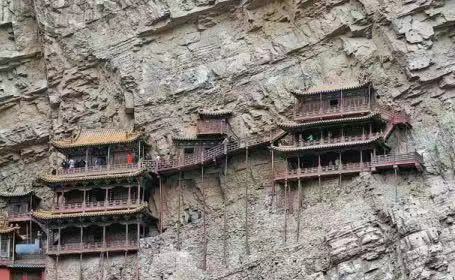
Xuankong Temple, built on a cliff face in Shanxi's Hengshan Mountain, is a prime example of engineering achievements in ancient China. SUN RUISHENG/CHINA DAILY
When talking about the ancient architectural wonders in Shanxi province, which is said to have the largest number of ancient buildings in China, Xuankong Temple in Hengshan Mountain, Hunyuan county is without a doubt a classic case ripe for study.
In the minds of many Chinese people, temples are mostly seen as structures built on the ground. But Xuankong Temple, which means "temple hanging in the sky", or suspending temple, is a strong exception.
The temple was built on the surface of a cliff and is one of only seven ancient temples in China with such a status, according to researchers.
Constructed out of wood, tiles and stone during the Northern Wei Dynasty (386-534), the temple is made up of two three-story pavilions and a yard linked by staircases and steps. The staircases and steps run along the surface of a sheer cliff rising 90 meters above a stream at the foot of the mountain.
Seen from below, Xuankong Temple appears extremely precarious. It is supported by only a few thin scaffolds rising from protruding rocks. For that reason, it was selected by Time magazine as one of the 10 most dangerous buildings in the world in 2010.
But "precarious" and "dangerous" are not the right adjectives for this structure preserved for more than 1,500 years. Despite several renovations in various historical periods, the temple has survived the winds, rains and earthquakes for one and a half millennia.
Researchers revealed some secrets behind what has kept the structure intact.
For instance, a number of large, deep holes were dug into the cliff's surface, and two-thirds of the length of the beams together with wedges were driven into each one. That structure offered a firm foundation for the whole temple.
Other than its sturdy construction, researchers have also found that the section of the cliff above the temple acts like an umbrella to shield the complex from rain and sunlight. In summer, when the day is longest, the temple only receives about two hours of direct sunlight a day during the morning.
The narrow valley it faces also changes the direction of airflow. The wind usually blows toward the cliff in the opposite direction of the temple, but rarely reaches the buildings.
Many tourists said that as the temple has been standing firmly on the Hengshan cliff for more than 1,500 years and is still intact and solid, a study of the temple is an exploration of an ancient Chinese engineering miracle.
The temple is used for worship by believers of Buddhism, Taoism and Confucianism.
There are nearly 80 statues of the three religions in the temple, showing how the Chinese nation's cultural inclusiveness has allowed the coexistence of different religions.